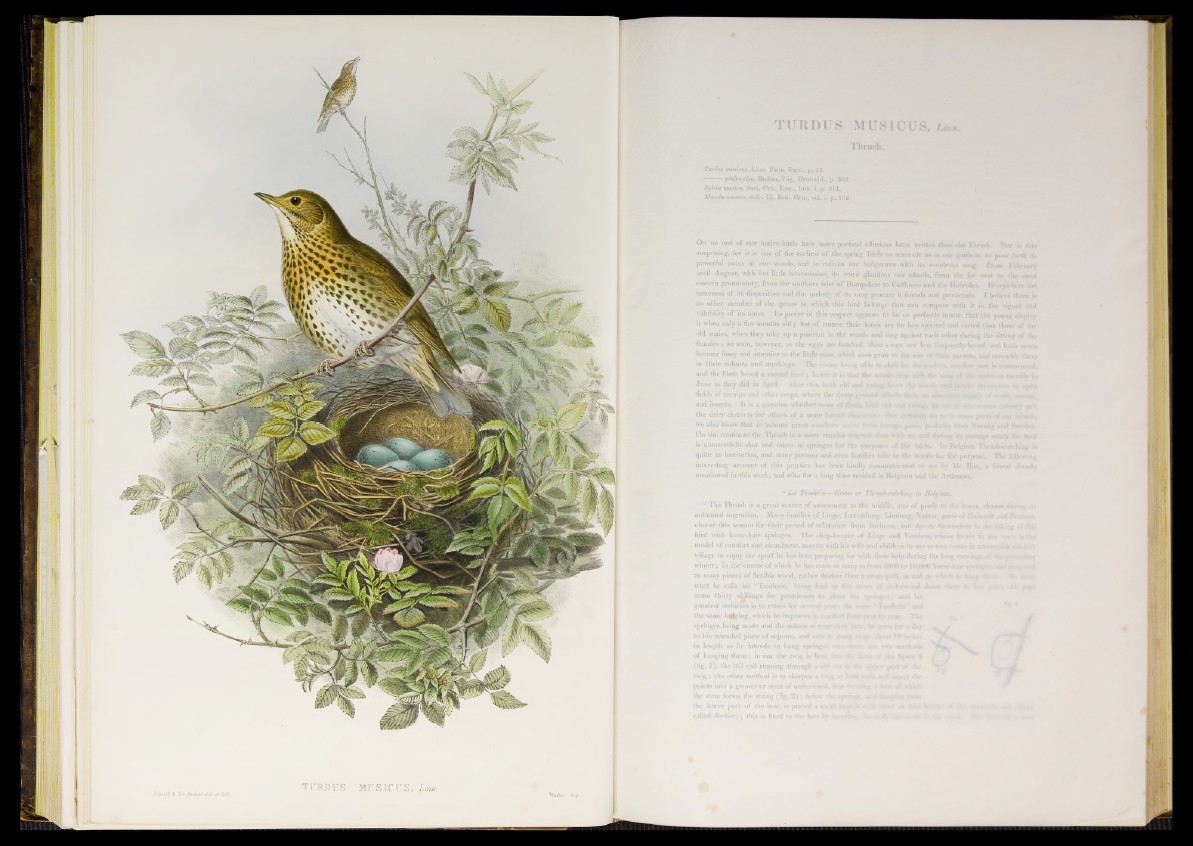
TURD ITS MUSKC US , Linn
Walter imp
T U RD US MU SIC US, u
Thrush.
Turdus musicus, Linn. Faun. Suec., p. 79.
philomelos, Brehra, Vog. Deutschl., p. 382.
Sylvia musica, Savi, Ora. Tose., tom. i. p. 211,
Menila musica, Sell). 111. Brit. Ora., vol. i. p. 162.
O n no one of our native birds have more poetical effusions been written than the Thrush. Nor is this
surprising, for it is one o f the earliest o f the spring birds to serenade us in our gardens, to pour forth its
powerful notes in our woods, and to enliven our hedgerows with its wondrous song. From February
until August, with but little intermission, its voice gladdens our islands, from the far west to the most
eastern promontory, from the southern islet o f Hampshire to Caithness and the Hebrides. Everywhere the
tameness o f its disposition and the melody of its song procure it friends and protectors. I believe there is
no other member o f the genns to which this bird belongs that can compete with it in the vigour and
volubility of its notes. Its power in this respect appears to be so perfectly innate, that the young display
it when only a few months o ld ; but o f course their tones are far less spirited and varied than those o f the
old males, when they take up a position in the woods and sing against each other during the sitting of the
females; so soon, however, as the eggs are hatched, their songs are less frequently heard, and both sexes
become fussy and attentive to the little ones, which soon grow to the sisee of their parents, and resemble them
in their colours and markings. The r-u I icing able to shift for themselves another neat » commenced
and the birds breed a second time ; hence it is that the woods n 't? with tb r unur <4 the •nafo merrily m
Ju n e as they did in April. After this, both old and vmreg !*-..<■ ?he wood» a m d t o unen
fields of turnips and other crops, where the damp gro*H*d them a n aftmtotiH
and insects. It is a question whether some of them. fo.-i voeng, dm a«*
the drier districts-for others of a more humid d w r s c t e t ;♦«•> irrtaudv rk> part# of our isbmd -
we also know that in autumn great numbers arrive from foreign parte, wubaMv from Norway and Sweden.
On the continent the Thrush is a more regular migrant than with ns, and during its passage south the bird
is unmercifully shot and taken in springes for the purposes of the table. In Belgium Thrush-catchiug is
quite an institution, and many persons and even families take1 to the woods for the purpose. The follow it).«
interesting account o f this practice has been kindly communicated to me by Mr. Box, a friend already
mentioned in this work, and who for a long time resided in Belgium and the Ardennes.
“ L a Tenderie—Grate- or Thrush-catching in Belgium.
“ The Thrush is a. g reat source o f amusement to the middle, and of profit to the lower, classes during its
autumnal migration. Many families o f Liege, Luxemburg, Limburg, Namur, part* of llainanh and Brabant,
choose this season for their period of relaxation from business, and devote themselves to the taking o f tin»,
bird with horse-hair springes. The shop-keeper o f Liege and Verviers, whose house in the town is the
model o f comfort and cleanliness, resorts with his wife and children to one o r two rooms m a . .. < ew *W
village to enjoy the sport he has been preparing f o r with their help during the long evening« of ~ p •■¥>■> dio-i
winter; in the course of which he has made as many as f r o m 5000 to 10,000 horse-hair .*¡*1 ■ ■ • ■ •
■as many pieces o f flexible wood, rather thicker than a swatt-qnill, in and on which to hang Hk him»
what he calls his * Tenderie,’ being four o r five acres of underwood about three to i« -
some thirty shillings for permission to place his springes; and his
greatest ambition is to retain for several year* the same ‘ Tenderie ’ and
the same lodging, which he improves in mmfort from year to year. The
springes being made and the season o f migrate«** n*ar. He goes f o r a dav f
to his intended place o f sojourn, and cuts as mwtj twig* ¿boot 18 inch«»
in length as he intends to hang springe* «•) • • k- <«v two methods y w .
of hanging th em ; in one the twig is brut into •
(fig. 1), the tail end running through a 4vj »'»« m the M|e»ci- nwt <•(' the
twig ; the other method is to sharpen « t w% ai both nwU insert the
points into a grower o r stem o f underwo«>d. thu< form»«# a how of which
the stem forms the string (fig. 2 }; below die vacing*. «md hanglag foam
the lower p art o f the bow, is placed a small tn^Kk
called Sorbier) ; this is fixed to the bow hy ¡mmMSn